Last week, we looked at the beginning of this little stitch sampler that I’m putting together as a summer class project.
Earlier this week, I showed you the line-up of stitches so far on the sampler.
Today, I’ll show you the finish. I’ll fill you in on the rest of the stitches I used, talk a bit about finishing the little sampler into a needlebook, and then I’ll show you the next thing I’m working on and the jolly mess that goes with it.
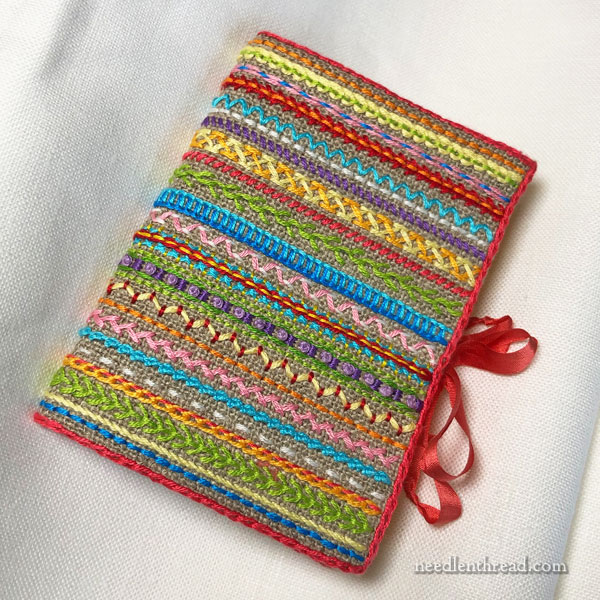
So here it is. This little sampler started out 6″ x 4″ and ended up folded into a 3″ x 4″ needlebook.
The finish for this is very easy and very manageable, making it a great approach for anyone who has never tried finishing needlework into something.
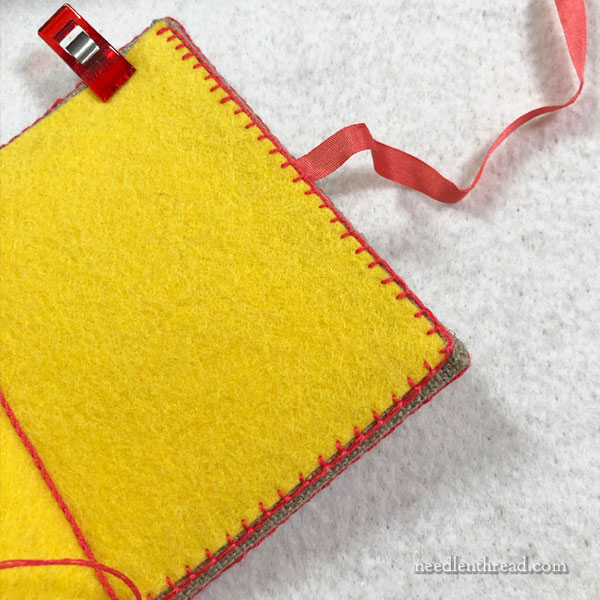
I’m afraid this is as close as I got to a step-by-step finish photo, though. I’m not sure why I didn’t take photos as I went – perhaps I was just too eager to get it finished!
In any case, the method is exactly the same as the little needlebooks in Lavender Honey & Other Little Things. The only difference is that this needlebook is larger.
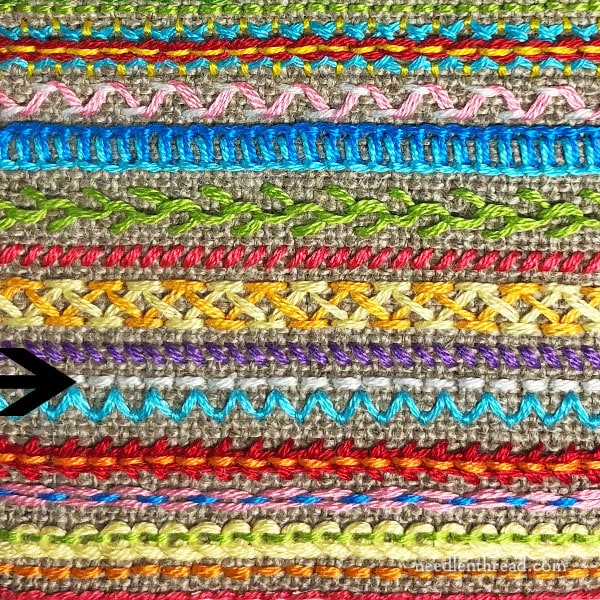
The other day, I named all the stitches used in this piece, up to the line where the arrow is pointing in the photo above.
Starting with that line, here’s the rest of the line-up:
19. Running stitch, in white.
20. Fly stitch, worked horizontally, in light blue.
21. Wheatear stitch in red, backstitched down the center in orange.
22. Running stitch in dark blue, laced in both directions with light pink.
23. Pekinese stitch with the foundation backstitch in light green and the loops in light yellow.
24. Backstitch in orange.
The barely-showing dark pink line at the base is the chain stitch outline around the sampler.
Switching Fabric & the Next Thing
After finishing the needlebook, I moved on to testing a different fabric for a simpler sampler (say that ten times fast!).
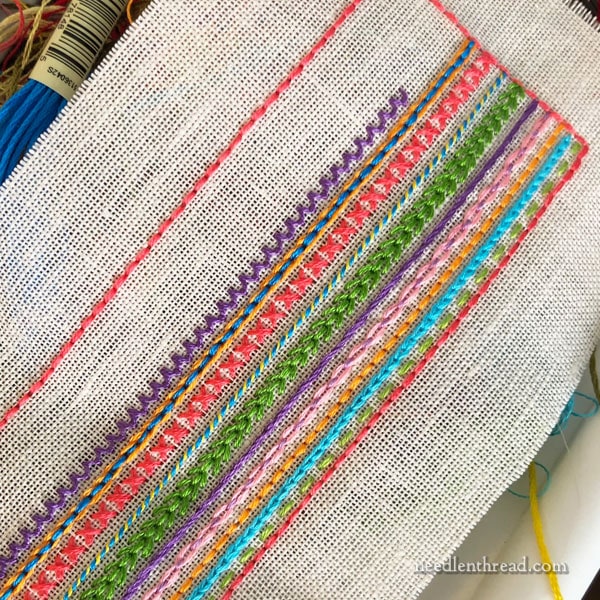
The idea behind this simpler sampler is to finish it as a bookmark. We will see.
There are fewer stitches in this sampler: running stitch, backstitch, chain stitch, stem stitch, fly stitch, and cross stitch. I’ve whipped a few of the stitches to add a little variety, but there’s a bit of repetition going on, and that’s ok, because that’s how people learn a particular stitch really well!
I’m using a 32 count linen on this one and it’s significantly lighter in color. I prefer the darker natural, so I’m going to look for a 30 – 32 count in a darker oatmeal / natural color. White shows up so much better on the darker naturals, and I think it always adds such a nice contrast when mixed in with lots of colors on a darker background.
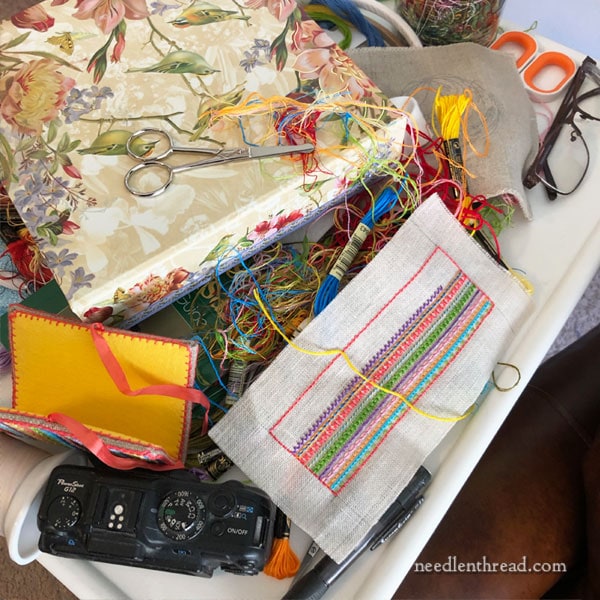
When I work on projects like this, I get kind of caught up on them and my workspace subsequently goes to pot.
It was neat at one point, I promise!
So that’s what’s up on this side of the computer screen at Needle ‘n Thread. This weekend, I’ll be working up a couple more experiments and getting my ducks in a row on a few other projects that are looming.
If you have any questions or want to join in the conversation about little stitch samplers and similar stuff, feel free to leave a comment below.
I hope you have a splendid weekend, and that you enjoy any time you can finagle for your needle and thread!
Hey, if you don’t have anything going, why not start a little sampler? You just need a small scrap of linen and random threads. It’s great fun!







Amazing! I have two similar projects going on: a needlecase (already finished) and a bookmark! :))
I love your little samplers. Love the colourfulness and the richness in variety, and the perfection in finishing it, too. It’s stunning what beauty you can create with a handful of the simplest stitches only.
My needlecase – should be named toolcase rather? – is HUGE in comparison (some 20 x 30 cm, I believe). It was the utilization of a Colbert background sampler of that size, but that is a good thing, because I wanted to store not only all my needles, but also scissors, tweezers and other tools in one place. You can have a look at it (and the whole story behind) on my website (link above in head of the comment).
The inner side of it is a kind of sampler as well. Each pocket got sewed down in a different surface stitch and colour. The biggest challenge was the Spanish Knotted Feather Stitch through two layers of felt (one of them 3 mm thick).
For the bookmark (it is supposed to be a gift), I used two initials out of your Tulip Alphabet (thank you!), stitched on a 60 ct. linen. Do you think it is hard to stitch on such a dense linen? It’s an excellent quality linen, but it’s my first approach to linen ever. I noticed that you have to use a #9 or even #10 crewel needle on it, and as soon as at least 2 layers of thread build up on the backside, it becomes hard to get your needle through.
Have a nice weekend!
Such an amazing thing to do with a sampler. It’s beautiful.
I love your work. Please keep it coming
Mary,
I have been looking for a way to practice some stitches but always stop as I never figure out what to do with it.
This is perfect, not too big too get bored with and small enough to make into something useful.
Thanks for the inspiration.
Melinda
Love all your posts! This sampler would make a beautiful cell phone cover…or makeup bag…or change purse…or pencil case…etc. You inspired me to work on a few gift items.
Thank you for your wonderful inspiration and information.
Raymonda
What a beautiful item you’ve made and so inspiring. Thank you
Hello:
Thank you for the idea. I now know what I will be giving my friends for gifts. Thank you for all of your news letters. I enjoy every one even if I do not use the information.
That is absolutely beautiful!
Loved seeing your space all messy! I try to keep everything neat and tidy but always fail☺️
Just goes to show you that we’re human – and that ENTROPY is a law of nature!
What a lovely idea! I’m in!
Absolutely GORGEOUS!!!
I do a lot of painted canvases that have borders or parts of the design that are one or two threads wide and I’m always scratching my head trying to find different stitches to make it interesting. Your sampler which I will print is valuable and I would love to see you print up a little booklet for sale with these examples that I could carry with me. (And, I’m sure i’m not alone in this)
Thank you
If anyone decides to make one of these little beauties, try to get actual wool felt instead of synthetics. Wool has been used for hundreds of years to store needles, as it doesn’t dull the points as synthetics do. The lanolin in raw wool also protected the needles from rusting.
This is 100% wool felt. I rarely use synthetic or even blends.
Truly gorgeous sampler. Your website never fails to inspire and lift the spirits. Thank you.
Now you have REALLY got me this time! Can’t wait to try the stitch sampler!
What threads are you using? Silk? Floss? Or crewel wool?
DMC cotton floss!
I’ve enjoyed seeing your stitch samplers and things you can make from them. I’m a knitting and needlework history researcher, and right now a friend and I are working on an article for Piecework on ticking embroidery, a popular technique in the 19th century, through the early 20th…this reminds me so much of that!It uses ticking as the fabric, and adds braids and cords to cover the ticking lines themselves, and then is transformed into small envelope style cases, sewing housewives, workbags, etc. I’m posting a couple of pictures in the FB group so you can see what I’m talking about….I love this!
Thank you so very much for your inspiration!! I embroidered as a child, became a quilt pattern designer but wanted to stitch something that did not have to be totally sewn on a sewing machine. I have done a lot of cross stitch but wanted to stitch something different, something I have never tried before. After my mom died I wanted to use the beads, brooches and miscellaneous I inherited from her. So, I stitched a banner that says ‘JESUS’. It helped me work through my grief and through that journey I discovered my own ‘look’ when it comes to needlework. I now hand stitch about 5 hours per day and continue to be enthralled with pieces that include the alphabet. Blessings! Diane
Mary, what type of felt did you use? Was it the felt sheets from craft store or felt from fabric? Love this idea!
Hi, Theresa – it’s 100% wool felt that I cut to fit. 🙂
Mary, I love this needle book and think it is a genius idea for an embroidery class project. So fun as it could be in any color scheme to suit the students. I think I’ll have to make a similar needle book for myself, as it’s just too cute to live without!
Mary I LOVE the way the needle book turned out. Love your blog and stitch tutorials. Love everything Mary Corbet.
Hello, Mary, I just wanted you to know that I really love all your stitches and your blog, all the explanations that you give, are very useful for me, keep doing it. Best Regards from Chile.
Maribel
Mary – this is a fun little project – I read your post in my inbox this morning and was tempted to just have some fun and let all the other things be !
Good way to learn and try different stitches, threads and fabric and make a useful item with such ‘doodle cloths’.
Trying not to get too tempted 😉 but a good post!
Hi, Nupur – it’d be such a fun weekend project!!! 🙂
Absolutely beautiful!! I feel confident I could do this one!!❤️
Looks great, you’ve inspired me to have a go.
What kind of linen do you stitch on? Can I buy this at a place like Joann’s in my town? (I am sure you have been gracious enough to say in the past, but I am relatively new to this)
Your help and wonderful instructions are greatly appreciated and enjoyed!
MaryAnn
Hi, MaryAnn – For needlework, you can really use any fabric, but if you want to use the linen the way I have here (using the “lines” of the weave as the stitch guides, to keep things straight), then you’re going to want to use a linen that’s made for needlework. Normally, these are found in dedicated needlework stores, called local needlework shops (you’ll see people abbreviate that to LNS). If you don’t have a local needlework shop where you can get about a 28 count linen, then you might need to order online. Needle in a Haystack in Alameda CA carries a wide range of needlework linen on their website. Hope that helps!
I love how that little notebook came out! I am going to have to try one myself 🙂
Mary, Thank you for your sharing and explanations.
I love the idea of stitch samplers, and using them in a needle book is such a great idea!
Thank you.
Mary, What a wonderful tutorial. Very beautiful finishing. Your stitches are so perfect!
Mary, You are always an inspiration! These would be perfect ideas for my grand-daughters to stitch – Thank you!
Judy
In Oz
Mary, this is a beautiful stitch sampler for needle books. I have been making mine in pretty Japanese fabrics, the only embroidery work has been all around the finished work. Great idea for me to put to use all the linen stash in my work room. So bright and pretty colors you used too.
Thank you.
Thank you very much indeed Mary for the Samplers bookmarks and Needle books. For me it’s all been very enjoyable and will asap start a needle book, embroidering needle Type Size Number and spacing out the size numbers enabling easy storage for ‘we who like things in order and in their right places’ ☺️ Definitely embroidering the Names like “Crewel” Maybe even make a book or two etc for my needle type collection. I love all your emails Mary, thank you. Susie x
I have been saving your emails so I can work on these samplers after I get the quilt I am making for my grandson for Christmas this year. It takes me quite awhile to get my quilts done. I started one for my granddaughter last year in July and I got it completed 2 weeks before Christmas last year. I am not able to work on them everyday due to taking care of my sick husband and all the errands I have to run. Anyway my grandson get his this year for Christmas. It has 35 block total with five across and seven down each block will be 10 x 10 and I am embroidery each block with a assortment of race cars, planes, fire trucks, monster trucks, helicopters, buses, police cars, and ambulances all embroidered by hand. It will be a good full size quilt when done. So I will be busy for the next several months so saving your emails to work on when quilt is done.
Hi Mary! I have the Little things ebook, but it looks like the felt pages are joined in differently here. Have you scooped up a few threads of the linen as you blanket stitched the felt page in? And did you do the lovely backstitch line down the centre first? It all looks fantastic! 😀 Thanks so much for this idea, it’s lovely. <3
Hi, Michelle – In the ebook, I whip stitched the felt into place. Here, I used blanket stitch around the edge. The construction, though, is the same. I added a stem stitch down the middle, to define the crease a bit and separate the two larger pages. Hope that helps!
I love your needlebook. I will do something similar. I think you had a very good idea
and it keep those stitches in mind…..
Thank you
Fabulous! Found you through Pinterest and I’ve been itching to try a sampler but really wanted it to have a useful purpose. Thanks so much.
Very nice sampler. Colorful, intricate, but simple all at the same time. I might like to try it for a crochet hook holder.
Dear Mary. Love your. Sampler. Great idea for Christmas. Presents. Your work is so beautiful.
Thanks so much, Irena!
Love the idea of this little sampler book. I do have a question. Once it is finished…what is it’s purpose. I see the felt on the inside. Is this to be used for needles and thread? A newbie so am learning. Thank you for sharing. Looking forward to doing this project.
Hi, Lorie – Yes, it’s a needle book. You just slide your needles into the felt to hold them in place, and you can then tote the little book around with you with your projects, so that you have have several types of needles on hand and stored safely.
Quick question, Mary. When working the bookmark do you use a hoop or other device or work it in hand?
I worked both of those in hand – the bookmark and the needle book. With kids, though, I think it’s easier for them to work in a hoop. So we will probably set up the fabric and add some cotton around it (to keep the fabric costs lower) and work from there.
Love the stitch sampler.
It could be so many things, just by adjusting the size and finish.
Any chance of a pdf covering materials, stitches and hints?
Hi, Phyllis – I’ll probably put something together with this, once I get all the samples worked up! Lots to do before then, but I’ll work on it as I can!
What is the fabric/thread count of the sampler? I’d like to try it.
Hi, Kate – you don’t need a linen of a specific count, but if you want to go that route, I’d look for something in the 25-30 range.
What did you use between the linen cover and wool inside? Batting? So pretty finished and useful. Love it.
Love this idea. I just amazed by your talent. Your art work is just incredible. Thank you for sharing it with all of us.
Hi Mary, I so enjoy your daily blog. I feel like you are a dear friend that connects with me daily. I started chemo last week and unfortunately my stitching days have been on hiatus(briefly, I hope). Your daily chat has kept me connected to my passion and I thank you for that. I love this little needle book . It is so colorful and cheerful. Eileen
Hi, Eileen – Sorry to hear about your chemo journey. I found that I had very little desire to stitch when I started going through chemo and radiation, but as the journey progressed and I didn’t feel like I was getting anything accomplished, I found that some light, casual stitching helped keep me focused on something other than the whole ordeal. I hope you have a good support group, family, friends, etc., to help you through! It does make a huge difference! May the journey be quick and the recovery be successful!
I was just rereading your postings on the Stitch Sampler Needlebook and I am in love with it. In your first post you mentioned you were looking for a suitable linen for the project and you would let us know what it was/is. What did you end up using and what was your source?
Thanks
Louise Pomes
this is a great idea.